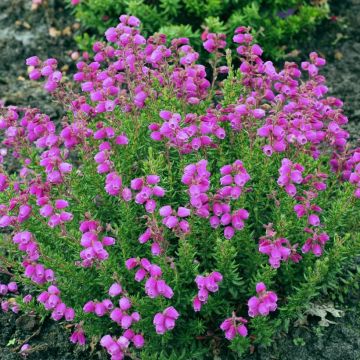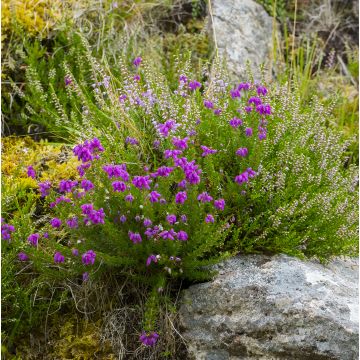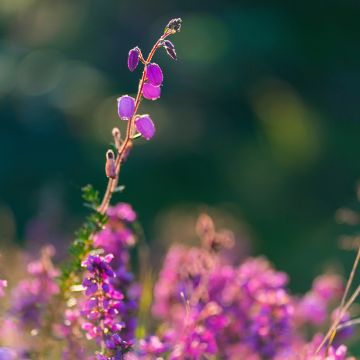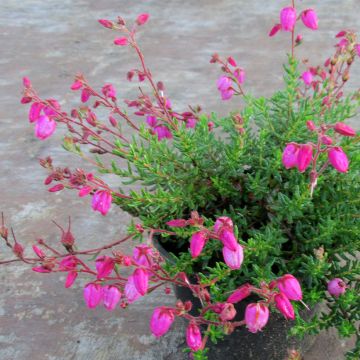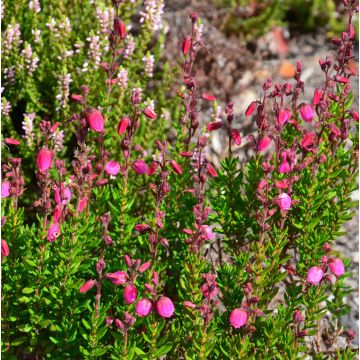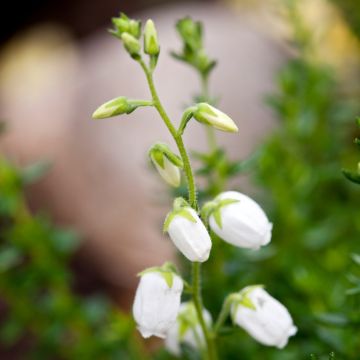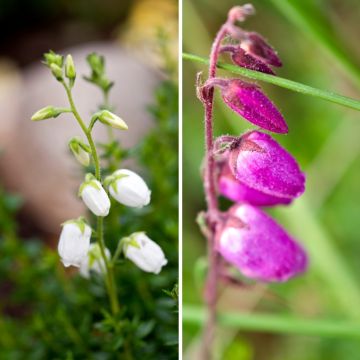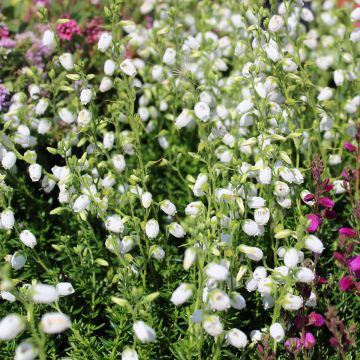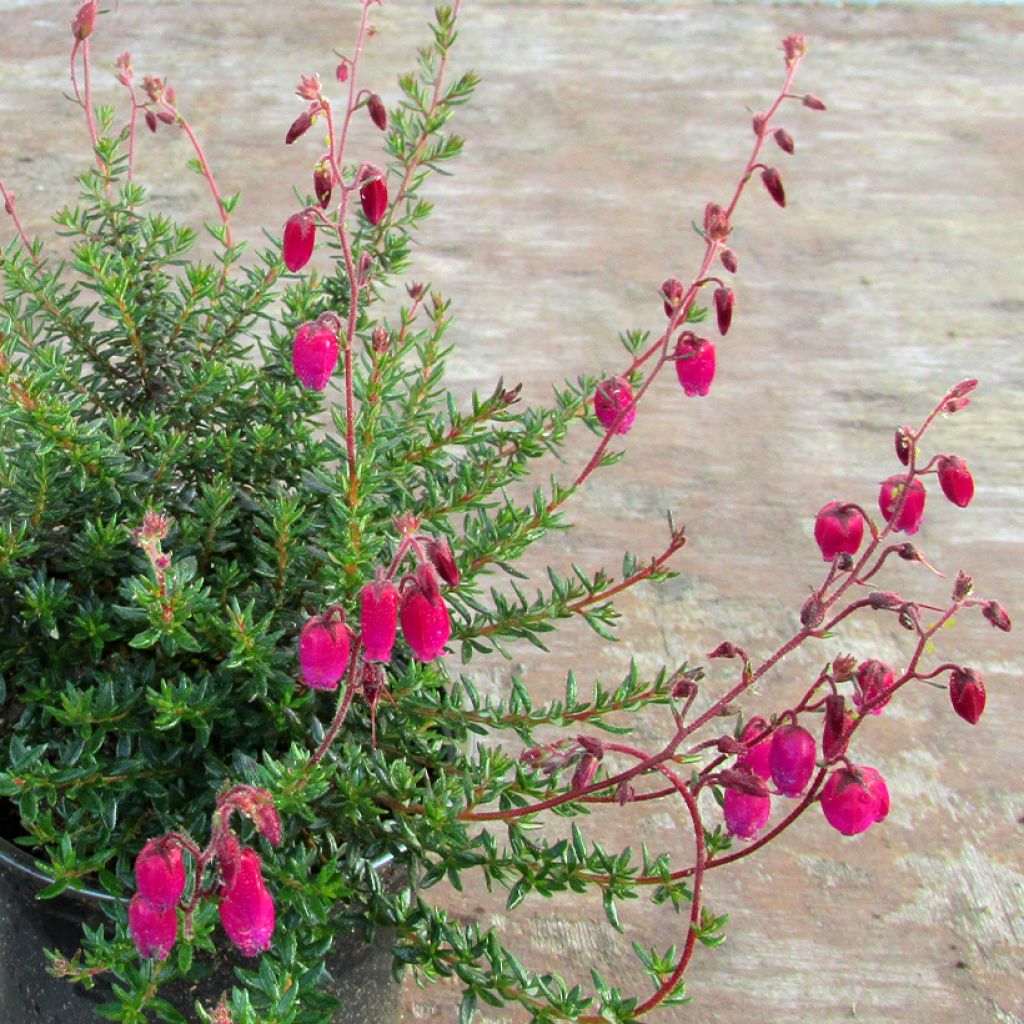

Daboecia scotica Goscote
Daboecia scotica Goscote
Daboecia x scotica 'Goscote'
Scottish Heather, Heather
This item cannot be shipped to the selected country
Delivery charge from €5.90
More information
Schedule delivery date,
and select date in basket
This plant carries a 24 months recovery warranty
More information
We guarantee the quality of our plants for a full growing cycle, and will replace at our expense any plant that fails to recover under normal climatic and planting conditions.
From €5.90 for pickup delivery and €6.90 for home delivery
Express home delivery from €8.90.
Does this plant fit my garden?
Set up your Plantfit profile →
Description
The Daboecia scotica 'Goscote' forms an undershrub with a low and spreading habit, distinguished by its long and generous summer flowering of ruby red. Its bell-shaped flowers are carried in clusters at the end of upright stems covered in small, dark green, evergreen leaves. Plant it in full sun or partial shade in acidic soil that remains moist without retaining too much water. This Irish heather is ideal for borders, containers, and heathland beds.
From the Ericaceae family, Daboecia is native to Western Europe, specifically Ireland, Spain, Portugal, and the Azores. D. x scotica is believed to be a hybrid between D. azorica and D. cantabrica. The St. Daboec heather grows naturally on the edge of woodlands and heathlands on acidic soil that doesn't dry out. It is hardy and can withstand temperatures around -15°C or even -18°C. The flowering of Irish heathers is melliferous and attracts pollinating insects.
The 'Goscote' variety is appreciated for its vibrant ruby red flowering, which lasts from June until the end of October or even November, depending on the region. It is covered in a multitude of bell-shaped flowers throughout the summer. They are clustered at the end of upright branches covered in lance-shaped, dark green leaves. Evergreen provides year-round decoration. This heather forms a wider-than-tall clump with a slightly spreading habit. It reaches a height of 30 cm and a width of 50 cm.
Hardy and easy to grow, the Daboecia scotica 'Goscote' thrives in poor, acidic soil. You can easily incorporate it into a bed alongside other heathland plants that flower in winter, such as Erica x darleyensis White Perfection, or in spring, such as Japanese azalea 'Ben Morrisson' with red and white flowers. This way, you'll have a blooming bed all year round. It can also be grown on a terrace or balcony using a sufficiently large container and acidic, moisture-retaining substrate.
Report an error about the product description
Plant habit
Flowering
Foliage
Botanical data
Daboecia
x scotica
'Goscote'
Ericaceae
Scottish Heather, Heather
Daboecia cantabrica subsp. scotica 'Goscote'
Western Europe
Other Daboecia
Planting and care
The Daboecia scotica 'Goscote' appreciates the full sun. As for the soil, it prefers acidic, moist, and well-drained soils. It cannot tolerate limestone, heavy, clayey, or dry soils. In regions with long and harsh winters, provide protection (winter cover or mulch). Remove faded flowers as they appear to encourage the emergence of new flowers.
Every year, after flowering, prune the faded branches to 2-5 cm from the previous year's shoot, making sure not to cut below the last green leaves.
Planting period
Intended location
Care
This item has not been reviewed yet - be the first to leave a review about it.
Haven't found what you were looking for?
Hardiness is the lowest winter temperature a plant can endure without suffering serious damage or even dying. However, hardiness is affected by location (a sheltered area, such as a patio), protection (winter cover) and soil type (hardiness is improved by well-drained soil).

Photo Sharing Terms & Conditions
In order to encourage gardeners to interact and share their experiences, Promesse de fleurs offers various media enabling content to be uploaded onto its Site - in particular via the ‘Photo sharing’ module.
The User agrees to refrain from:
- Posting any content that is illegal, prejudicial, insulting, racist, inciteful to hatred, revisionist, contrary to public decency, that infringes on privacy or on the privacy rights of third parties, in particular the publicity rights of persons and goods, intellectual property rights, or the right to privacy.
- Submitting content on behalf of a third party;
- Impersonate the identity of a third party and/or publish any personal information about a third party;
In general, the User undertakes to refrain from any unethical behaviour.
All Content (in particular text, comments, files, images, photos, videos, creative works, etc.), which may be subject to property or intellectual property rights, image or other private rights, shall remain the property of the User, subject to the limited rights granted by the terms of the licence granted by Promesse de fleurs as stated below. Users are at liberty to publish or not to publish such Content on the Site, notably via the ‘Photo Sharing’ facility, and accept that this Content shall be made public and freely accessible, notably on the Internet.
Users further acknowledge, undertake to have ,and guarantee that they hold all necessary rights and permissions to publish such material on the Site, in particular with regard to the legislation in force pertaining to any privacy, property, intellectual property, image, or contractual rights, or rights of any other nature. By publishing such Content on the Site, Users acknowledge accepting full liability as publishers of the Content within the meaning of the law, and grant Promesse de fleurs, free of charge, an inclusive, worldwide licence for the said Content for the entire duration of its publication, including all reproduction, representation, up/downloading, displaying, performing, transmission, and storage rights.
Users also grant permission for their name to be linked to the Content and accept that this link may not always be made available.
By engaging in posting material, Users consent to their Content becoming automatically accessible on the Internet, in particular on other sites and/or blogs and/or web pages of the Promesse de fleurs site, including in particular social pages and the Promesse de fleurs catalogue.
Users may secure the removal of entrusted content free of charge by issuing a simple request via our contact form.
The flowering period indicated on our website applies to countries and regions located in USDA zone 8 (France, the United Kingdom, Ireland, the Netherlands, etc.)
It will vary according to where you live:
- In zones 9 to 10 (Italy, Spain, Greece, etc.), flowering will occur about 2 to 4 weeks earlier.
- In zones 6 to 7 (Germany, Poland, Slovenia, and lower mountainous regions), flowering will be delayed by 2 to 3 weeks.
- In zone 5 (Central Europe, Scandinavia), blooming will be delayed by 3 to 5 weeks.
In temperate climates, pruning of spring-flowering shrubs (forsythia, spireas, etc.) should be done just after flowering.
Pruning of summer-flowering shrubs (Indian Lilac, Perovskia, etc.) can be done in winter or spring.
In cold regions as well as with frost-sensitive plants, avoid pruning too early when severe frosts may still occur.
The planting period indicated on our website applies to countries and regions located in USDA zone 8 (France, United Kingdom, Ireland, Netherlands).
It will vary according to where you live:
- In Mediterranean zones (Marseille, Madrid, Milan, etc.), autumn and winter are the best planting periods.
- In continental zones (Strasbourg, Munich, Vienna, etc.), delay planting by 2 to 3 weeks in spring and bring it forward by 2 to 4 weeks in autumn.
- In mountainous regions (the Alps, Pyrenees, Carpathians, etc.), it is best to plant in late spring (May-June) or late summer (August-September).
The harvesting period indicated on our website applies to countries and regions in USDA zone 8 (France, England, Ireland, the Netherlands).
In colder areas (Scandinavia, Poland, Austria...) fruit and vegetable harvests are likely to be delayed by 3-4 weeks.
In warmer areas (Italy, Spain, Greece, etc.), harvesting will probably take place earlier, depending on weather conditions.
The sowing periods indicated on our website apply to countries and regions within USDA Zone 8 (France, UK, Ireland, Netherlands).
In colder areas (Scandinavia, Poland, Austria...), delay any outdoor sowing by 3-4 weeks, or sow under glass.
In warmer climes (Italy, Spain, Greece, etc.), bring outdoor sowing forward by a few weeks.


































